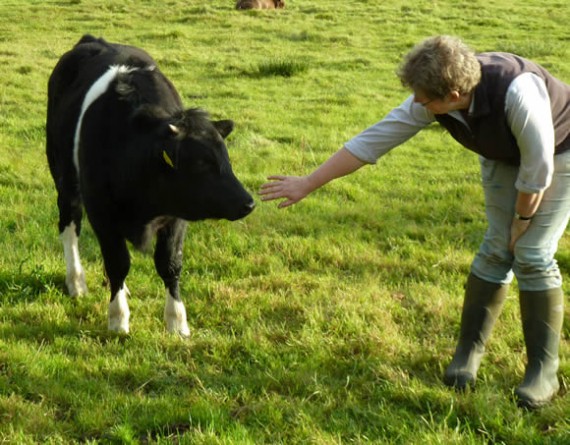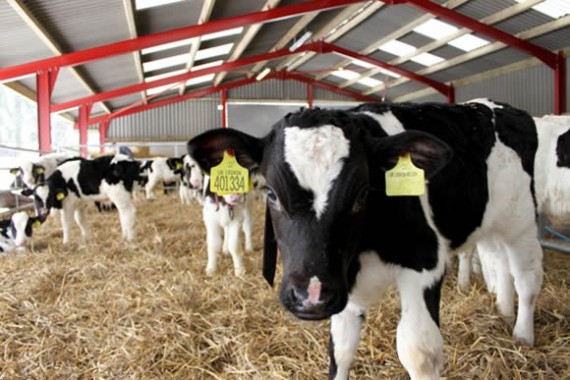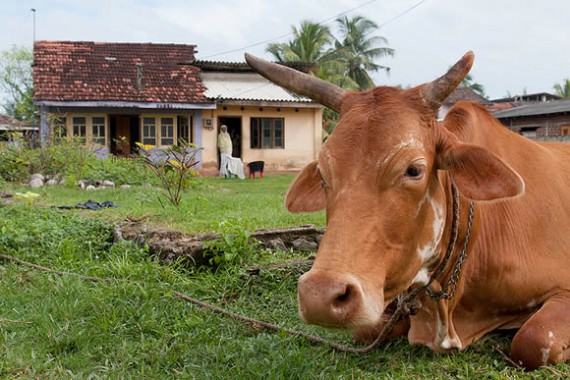Enterprises involving cattle
If you decide that, in principle, cattle-keeping is something you’d like to consider, you need to spend some time thinking about the possible enterprises that you could undertake.
Milk Production
If you want milk from your cattle enterprise, then you will have to breed cattle since a cow has to have a calf before she will produce milk.
Of course, you could do something like buy a cow in milk then sell her on when she dries up, but I don’t think that’s really practical. I’ll come back to breeding cattle later.
A dairy herd
I’m not going to say much about establishing and running a commercial dairy herd, as it’s not likely that the average smallholder will want to establish one. If you do, you need specialist advice and probably your head examined! :-)
Commercial dairy farming in the UK today is highly intensive, highly specialised and needs significant capital investment.
Beef and veal
If you only want to produce beef (or veal), then you don’t have to get involved in breeding cattle yourself unless you want to. You can buy in cattle at almost any stage of their young lives and finish them yourself.
 Our Shetland bullock, Henry, bought at six months of age to finish for beef.
Our Shetland bullock, Henry, bought at six months of age to finish for beef.
Most farmers aim to finish beef cattle before 30 months of age because after this age, the slaughter and butchery becomes more expensive due to disease control regulations. Veal animals are slaughtered around six to nine months of age.
There are three stages at which beef cattle are generally purchased – as baby calves for calf rearing or multi-suckling, as weaned calves or as stores.
Calf rearing
Buying in young calves at a few days old, rearing them on milk replacement via a bucket or teat, before weaning at about eight weeks is a relatively low cost way of getting into cattle.
If you are only keeping a few, the requirement for capital investment is low – calves cost about £150 each (at December 2012), depending on breed and gender, plus some penning, buckets, teats etc. but you will have a long wait for your beef and you need a good level of stockmanship as calves, like most young animals, are quite vulnerable to disease. Because the cattle get used to people from a young age, they are easy to halter train or handle.
These calves will come from the dairy herd, so will be either pure dairy breed or a beef breed x dairy breed. Since pure dairy heifers are kept as replacements for milkers, any pure dairy calves available will be bulls.
Commercially, dairy bull calves are reared in specialist units, kept entire (which has handling and safety issues), fed a diet high in cereals and finished at about fifteen months of age, often without ever being on grass. Because of the way the dairy breeds have developed in terms of carcase conformation and physiology, this is generally held to be the only way to produce beef commercially from the dairy herd.
Without specialist housing and handling facilities, keeping dairy bulls probably isn’t an enterprise for the novice cattle keeper.
However, beef x calves from the dairy herd can be raised for beef (or heifers used for breeding) on a mixed forage diet, usually supplemented with cereals. Bull calves will be castrated close to birth, as tup lambs often are, and the calves will probably need to be dehorned. Horns are a breed trait not a gender one – all the dairy breeds are naturally horned; some beef breeds are horned and some naturally polled (hornless). More about castration and dehorning in the Health and Welfare section.
The success of such an enterprise depends primarily on two things – firstly, sourcing good quality, healthy calves that have received adequate and timely colostrum and secondly, maintaining strict hygiene and excellent husbandry once you get them home.
Young calves are extremely vulnerable to infections that can at best hamper their growth and development and at worst, kill them.
If you decide to try calf rearing, I suggest you either find a reliable local dairy farmer who will be willing to sell you a few calves or find a specialist dealer. Do not be tempted to buy through an open market unless you are experienced.
Veal production
Veal isn’t really very popular in the UK, which is a shame because rosé veal is lovely meat. It has suffered because of the justified negative association with the practice of rearing veal calves in small crates, in the dark, on an inadequate diet (milk only) for a young ruminant, to produce white veal.
The rearing method deprives the calf of iron, resulting in a white flesh. This is how veal is produced on the Continent. However, veal crates are banned in the UK and many producers in this country produce rosé veal, raised to high welfare standards.
 Rosé veal calves at Heaves Farm
Rosé veal calves at Heaves Farm
The animals used in veal production have traditionally been dairy bull calves, fed on milk for a couple of months, then a forage or “forage plus milk” diet until slaughter at around six to nine months old.
Because it’s a fairly specialised end product, you will need to think very carefully about how you are going to market and sell the veal, if you want to consider this as an enterprise.
Weaned calves
Weaned calves can come from the dairy herd, as above, or from the beef herd. Weaned calves from the beef herd will have suckled their mothers for six months or more; it is likely that they will have been handled only rarely and they may have been running on hill pasture, well away from human contact – I say this because these calves can be a bit challenging to handle J
Weaned calves are often sold through livestock markets in the autumn or you may be able to buy privately.
Stores
Store cattle are those that aren’t quite ready for slaughter, so may be around 15 to 18 months old. The big store sales are in the autumn – these cattle will be “stored” over the winter on a forage diet to keep them growing but not laying down fat then “finished” off grass the following summer.
Obviously, the older (and bigger) cattle are when you buy them, the more they cost but you don’t have to invest as much time or feed until you get a return.
The beef suckler herd
OK, so this is into breeding cattle now. Much of the UK’s beef comes from the suckler herd. Cows calve annually, usually in spring or autumn, with the calf being weaned between six and nine months old.
The gestation period of a cow is nine months, so she will be back in calf (hopefully) by the time her calf at foot is three months old, ready to begin the cycle again. The resultant calves are either used for breeding or for beef. A suckler herd is probably the most natural way to keep cattle.
Multi-suckling
Multi-suckling is just what it sounds like, really. A cow almost always has only one calf (twins occur in about 5% of births) but she has the capability to raise two, or sometimes more, calves, depending on her breed, genetics and therefore milk yield.
As with calf rearing, the key is getting good, healthy calves at the right time to twin on. And some cows take to multi-suckling better than others. If you have a suitable cow – an older cow is generally better than a heifer, which is still growing itself - and can get suitable calves, it’s a good way to increase the productivity of your cattle herd.
A multi-suckling enterprise could be run as part of a suckler enterprise or using a house cow of suitable breed.
The House Cow
Ah, that’s better. :-)
Now, this is smallholder territory. So what is a house cow? The house cow is a versatile, dual purpose animal that is kept to provide enough dairy produce for the smallholder and his family, with perhaps extra to be made into butter or cheese for sale and, in addition, she will successfully raise a calf every year, either as a replacement for herself, for sale or for beef.
Before the Second World War, before farming became agribusiness and industrialised, a dual-purpose house cow would have been a common occurrence and a suitable animal relatively simple to find. Many of the traditional breeds of cattle that prevailed at that time were essentially dual-purpose and able to do the job and every region of Britain had its own breed.
 The house cow is international - this one in Sri Lanka. Photo: Photosightfaces
The house cow is international - this one in Sri Lanka. Photo: Photosightfaces
And fortunately, many of these traditional breeds are still around. Alternatively, a beef x dairy animal can make a very good house cow and a pure dairy breed would yield enough to provide for the house and support multi-suckling.
There will be further articles on the house cow later.
- Previous « Cattle legalities and practicalities
- Next Cattle Breeds »

About Rosemary Champion
Rosemary lives on a 12 acre smallholding in Angus, in the east of Scotland, where she keeps Ryeland Sheep, Shetland cattle and assorted poultry. She was destined to be a smallholder from an early age.
Further Reading
 Caring for Cows Val Porter |  Practical Cattle Farming Kat Bazeley |  The Illustrated Guide to Cows Celia Lewis |  Cows for the Smallholder Val Porter |  |













